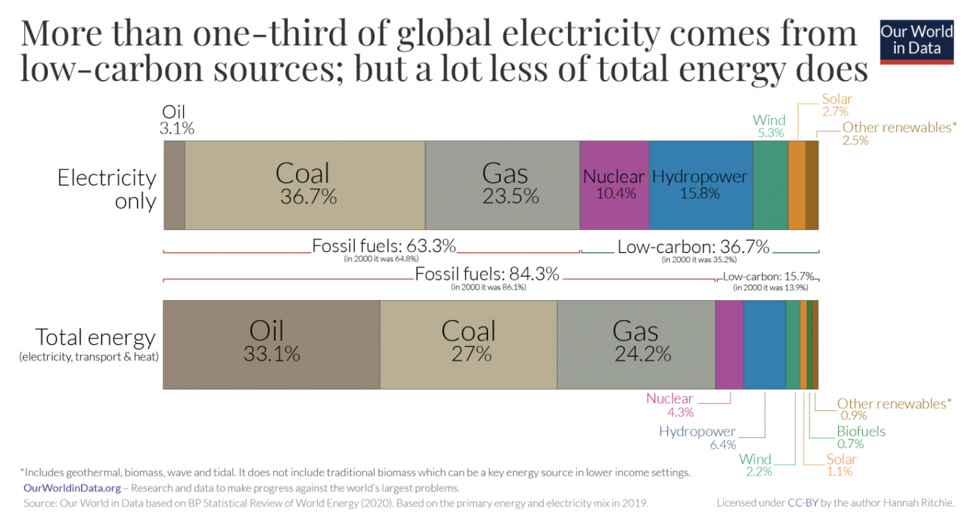· 4 min read
In the past 10 years, global wind and solar power growth has outpaced mainstream energy models. In 2010, solar and wind combined made up only 1.7% of total global electricity generation. By 2020, this number climbed to an amazing 8.7%. Wind and solar actually achieved exponential growth, while most models projected linear growth. They had already exceeded 2030 predictions by 2018.
This exponential growth was really exciting. It showed that we could indeed scale up renewables on our way to a clean energy future. The biggest helper was rapidly falling costs. Since 2010, solar and wind have become cost competitive with fossil fuels. Solar photovoltaic technology experienced an 85% decrease in cost, and costs halved for both onshore and offshore wind.
These falling costs happened because of positive feedback loops — the more the development of these technologies increased over the past two decades, the more they were able to harness economies of scale and competitive supply chains. This in turn lowered costs, spurring more deployment. It also helps that renewable technologies are modular and standardized.
The driver behind these positive feedback loops was social popularity. They became a social symbol for fighting climate change and promoting a sustainable world, which gave them immense political influence. This support attracted plenty of financing and led to market incentives like renewable tax credits and feed-in tariffs. Installing rooftop solar panels also became socially infectious. In California, rooftop solar became so incentivized through net metering that some of the costs that solar panel owners avoided shifted to non-solar customers.
Yet the same revolution never occurred for the nuclear power industry, an industry that provides 10% of the world’s electricity, completely carbon-free. Unlike solar and wind, nuclear power has always struggled to gain political support on a global scale. Countries including China, India, and Russia have strong nuclear programs and have made serious commitments to building new reactors. For perspective, however, there are currently 54 new nuclear reactors under construction, but 8,500 coal plants on earth.

On an episode of The Power Hungry podcast , hosted by Robert Bryce, Terrestrial Energy CEO Simon Irish explained: “It’s irrefutable that that policy commitment [to wind and solar] held up a massive green sign to private capital and industry to get capital to innovation in that sector. Nuclear needs that green go sign.” Government investment in research and deployment (R&D) has been essential in promoting innovations in renewables — China, Europe, US have become leaders in wind and solar through policy support.
The same level of policy support and sustained access to finance the wind and solar industries have enjoyed would benefit the nuclear industry. Ideally, this would enable the buildout of entirely new fleets of power plants in the US, both conventional and advanced, and unlock new gigawatts of clean energy capacity. This happened in France on a massive scale. The policy environment became favorable to nuclear power during the 1970s, and France massively scaled up its nuclear generation. France now operates at 80% clean electricity, thanks to its 56 nuclear plants and some wind generation.
The exponential growth of renewables can’t go on forever. As more solar and wind enter the market, grid inefficiencies start to crop up. In electricity markets that are oversaturated with too much intermittent generation in one place, consumers have begun to experience price volatility and blackouts. The Texas power crisis and blackouts that occurred in February of 2021 serve to illustrate this point. Communities must be electrified as efficiently, sustainably, and reliably as possible. Despite projected growth in global electricity demand, power suppliers in places like Europe and the U.S. are continuing to add unreliability. The costs of this are still not fully understood. (This article takes a deep dive into the limitations of solar and wind throughout their lifecycles.)
Mr. Irish says, “Nuclear is now viewed, by anyone who wants to hold a credible position in their commentary of the energy challenges facing us, as an essential part of our energy mix. . . If you look at recent polls, you see a very healthy movement toward an increasingly supportive attitude [among the public] toward nuclear energy.”
Future Thought Leaders is a democratic space presenting the thoughts and opinions of rising Energy & Sustainability writers, their opinions do not necessarily represent those of illuminem.
References
https://www.wri.org/insights/growth-renewable-energy-sector-explained
https://www.lucidcatalyst.com/_files/ugd/2fed7a_c05eb0c0e33748a597008fa4ba7bf6a0.pdf
https://www.irena.org/publications/2021/Jun/Renewable-Power-Costs-in-2020






